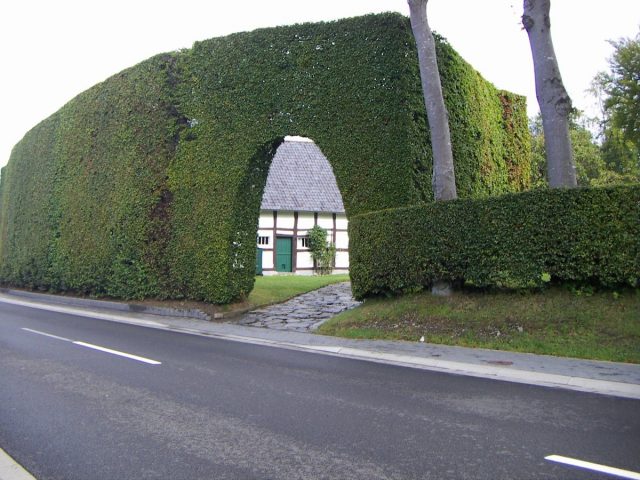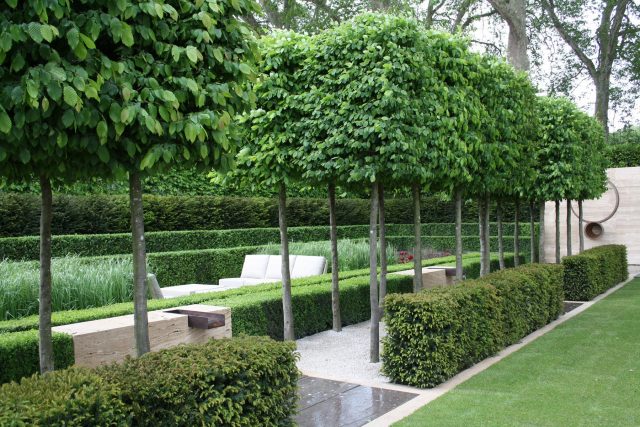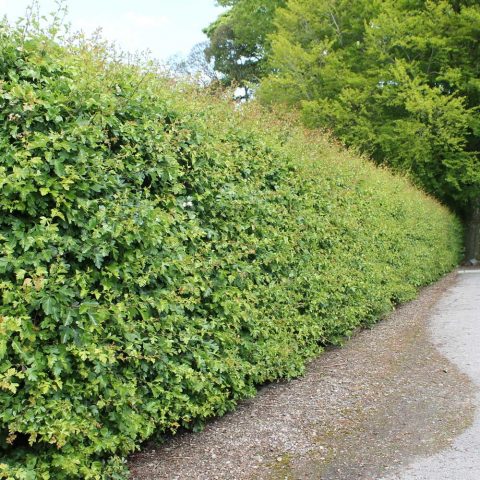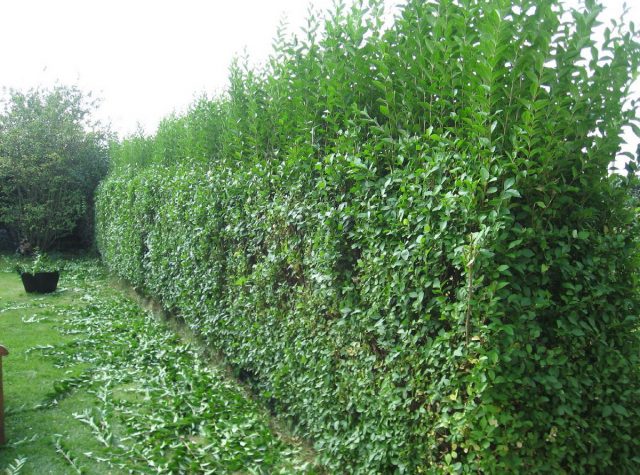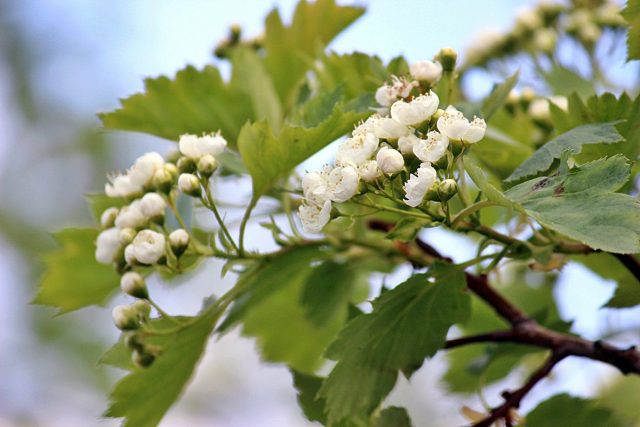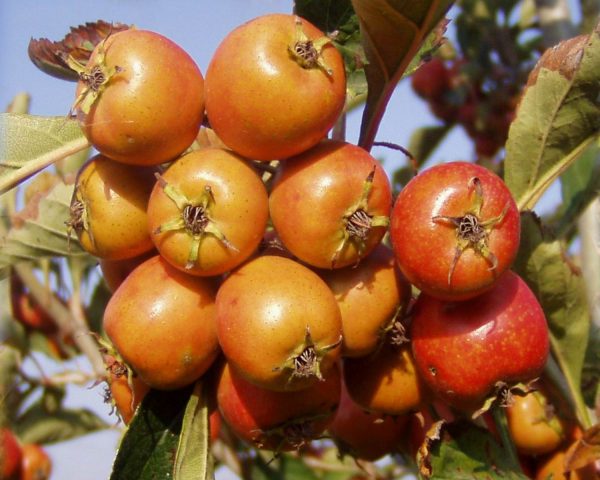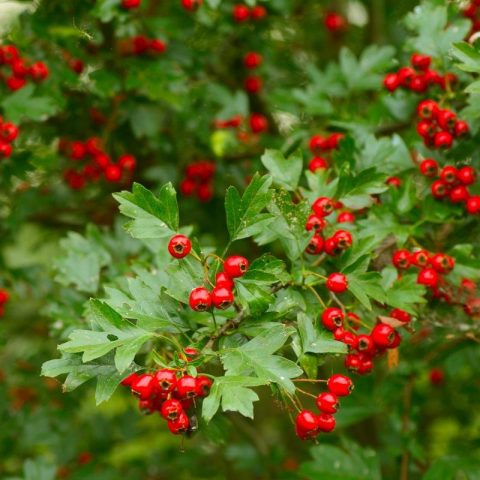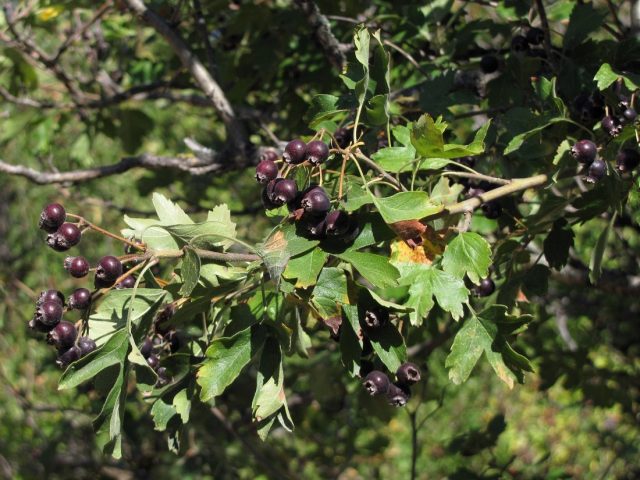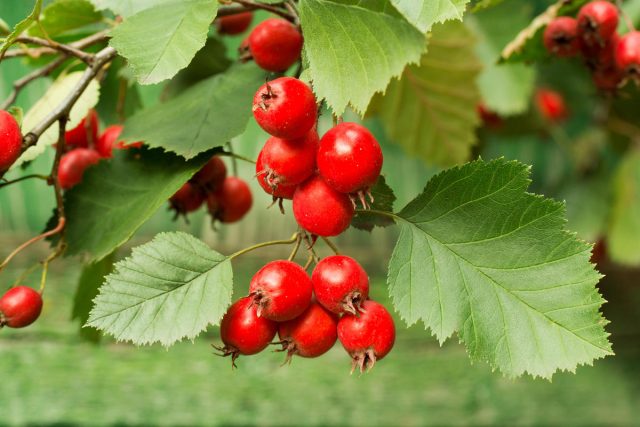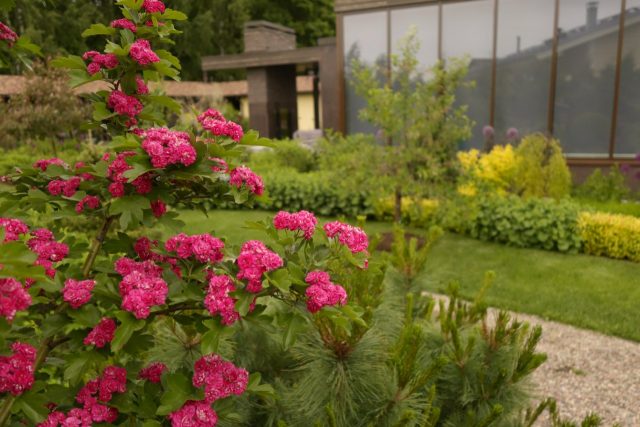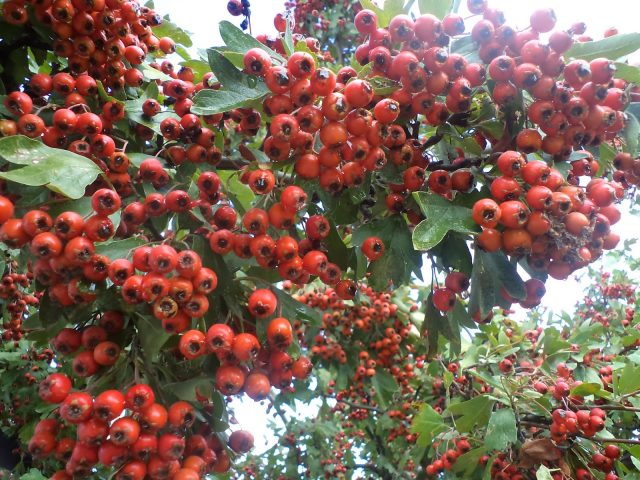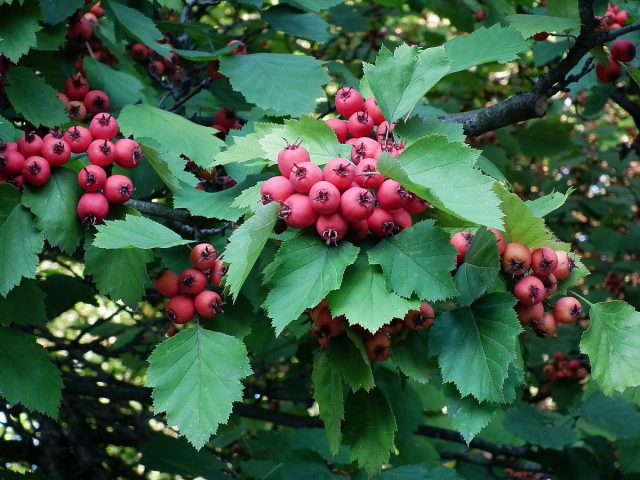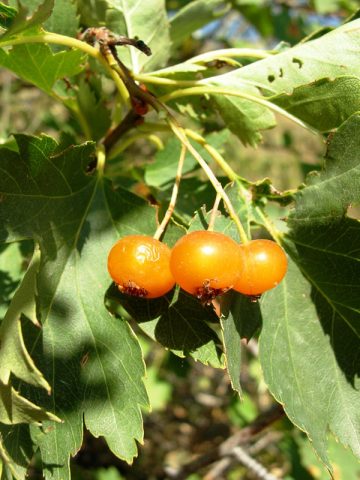Content
A hawthorn hedge is used in the design of the site, as an element of a decorative design solution. It carries a functional load, the shrub is used to protect the territory. The crop has a variety of hybrid ornamental varieties, allowing the creation of a low fence or hedge up to 5 m in height.
The use of hawthorn in landscape design
Hawthorn belongs to perennial deciduous shrubs. Suitable for decorating large areas and small areas. The species differ in the structure of the shoots, the color of flowers and fruits. Decorative hawthorn is used to decorate the territory as:
- a berry plant with bright red, yellow or black fruits;
- deciduous culture, which by autumn changes the color of the crown to spectacular red and yellow shades;
- flowering shrub with large flowers: white, pink, deep red.
On the site, the culture is grown in a tree or standard form, in the form of an ornamental shrub. Single or group plantings are used in the design, in the photo below is an example of a hawthorn hedge.
Decorative hawthorn is used as:
- Dividing element of the zones of the plot.
- A hedge along the edges of the garden path to create an alley.
- The background shrubbery near the wall of the building.
- Decorative design of the edge in the park area.
- The background is on the beds, the center of the flower bed.
- Combined with conifers.
- Creation of various decorative forms or strict dominant accents.
- Design solution for decorating recreation areas.
A tall hawthorn hedge is used as a camouflage for sanitary areas in public places. Serves as a good screen from the wind and polluted air of megalopolises.
How to choose a hawthorn variety for a hedge
The culture has a large number of decorative varieties; for arranging a hawthorn hedge with their own hands, they choose a shrub, taking into account the functionality and characteristics of the plant:
- a tall-growing species is suitable to protect the site;
- if the goal of the design direction, choose a shrub that lends itself well to cutting, undersized:
- there are a number of species that prefer sandy soils or loamy, slightly alkaline, for others, the composition of the soil is not fundamental;
- differ in shade tolerance and drought tolerance;
- take into account the peculiarity of growth: woody, standard, shrub.
How fast a hawthorn hedge grows
A perennial culture planted on the site has been growing in a permanent place for several decades. The first 3 years does not require constant crown formation, the annual growth is within 20 cm. After 5 years, the growth is up to 40 cm. Depending on the species, it blooms for 5-8 years, the grafted ornamental varieties bear fruit earlier. A hedge of 2 m in height can be formed 8 years after planting by cutting off the side shoots.
Hawthorn varieties for hedges
To create a hedge, species with a pyramidal crown are planted. As part of the composition, as a single element, take varieties with a lowered (weeping) crown. The list of varieties of decorative hawthorn and their photos, popular among professional designers and amateur gardeners, further.
Fisher's hawthorn
The species is classified as deciduous decorative trees and shrubs, another name is Songar hawthorn, Dzhungar hawthorn. It grows up to 6 m in the central part of Russia, in the south - up to 8 m.Frost-resistant hawthorn (-270 C). Grows on slightly acidic, slightly alkaline, loamy or sandy soils. Possesses high shoot-forming ability. The plant is shade-tolerant, does not require constant watering. The peak of decorativeness during flowering and fruiting.
External characteristic:
- the main trunks are light gray, the branches are dark cherry, the thorns are 10 mm;
- leaves are wedge-shaped, 7-lobed, carved along the edge, 3 cm long, light green with a gray tint;
- inflorescences are complex, 4.5 cm in diameter, white flowers, 1.2 cm in size, pink anther;
- fruits - 1.5 cm, round, maroon with white blotches, yellow flesh.
Fruiting from 7 years old, the fruits ripen at the end of September. It is used for row planting, hedges, in a group.
Fan-shaped
A representative of ornamental trees, fan-shaped hawthorn grows along river banks and on flat terrain. Found in the Arkhangelsk, Oryol regions. A multi-stemmed tree with a height of 6 m.
Description of the plant:
- branches are upright, sinuous, brown with a green tinge, intense studding, spines - 10 mm, young shoots are light gray;
- leaves are wide at the base, tapering upwards, up to 7 cm long, carved along the edge, dark green;
- inflorescences are complex, density - 12 flowers, flowers are white, anthers are light pink;
- fruits in the form of an ellipse, rich red color, yellow flesh.
The hawthorn blooms in mid-May, at the 6th year of the growing season. The fruits ripen in early October. The tree is undemanding to the composition of the soil. Prefers open sunny areas, drought-resistant. It is used for planting in a row, creating a hedge, in a composition, as a single plant.
Point
Point hawthorn refers to the type of ornamental trees and shrubs, reaches up to 10 m. The crown is dense, the first circle of branches forms low from the ground. The tree is spreading, with short central trunks, the branches are horizontal.
Appearance of decorative hawthorn:
- perennial branches of dark gray color, young brown, sparse thorns, up to 7 cm, with a curved end;
- leaves are large, whole, dark green, in autumn they change color to bright orange;
- flowers are white, large, with yellow or red anthers;
- fruits are round, 12 pieces per bunch, brown or yellow.
Fruiting in October, prefers loamy, neutral soils. Average frost resistance. Freezing of young growth is possible. It is used for single planting, massif, hedges of protective value, for planting in a row.
Pinned
Hawthorn Peristonidrezny representative of ornamental trees and shrubs, belongs to the Far Eastern species. It grows in the form of a spreading shrub 4.5 m high, the growth is slow. Fruiting from 7 years in mid-August. The culture is frost-resistant. For a full-fledged growing season, fertile, drained soils are needed.
Leaves, flowers and fruits give decorativeness to the shrub:
- the plant has a high shoot-forming ability, the shoots and perennial branches are dark gray, the thorns are rare;
- drooping inflorescences, large flowers - 1.3 cm, white or cream-colored petals;
- the leaves are dark green, from the middle of summer they change to yellow, and by autumn to a red tint;
- fruits are large - up to 1.5 cm, pear-shaped, deep red.
The plant does not tolerate shade and drought well. It is used to decorate garden and park areas.It lends itself well to pruning when forming a hedge.
Almaatinsky
An ornamental tree, less often a shrub, Alma-Ata hawthorn, belongs to the low-growing species, reaches a height of up to 5 m. A plant with wide branching, the crown is formed low from the ground, pyramidal in shape.
External characteristic:
- perennial branches are dark brown, young growth with a smooth structure, dark beige, spines are rare, hard;
- flowers are large, 8 pieces per inflorescence, pink or cream;
- leaves are large, dissected with teeth along the edge;
- berries are bright red at the stage of technical ripeness, when ripe they change to black.
Historical homeland - Kyrgyzstan. The plant is light-loving, tolerates moisture deficit well. Unpretentious to the composition of the soil, medium frost resistance. It is used in the design of the territory as a single plant, in a group, as a background hedge.
Five-papillary
Hawthorn Pentapestichny (Pentacular hawthorn) refers to ornamental trees and shrubs. Grows in the Crimea, in the Caucasus, reaches up to 8 m in height. The gain is intense. Average frost resistance, culture demanding on the composition of the soil (slightly alkaline, sandy). Used in the hybridization of ornamental varieties.
External characteristics:
- crown of regular pyramidal shape, perennial branches are brown, shoots of gray shade, thorns are small, numerous;
- leaves are dark, green on top, a tone lighter in the lower part, broadly wedge-shaped, carved;
- large flowers with white petals, burgundy anthers;
- fruits are large, black, with a glossy shade.
Used in an array, in group plantings, as a hedge.
Smooth
Hawthorn Smooth (Common, Thorny) - a variety of ornamental trees and shrubs, deciduous culture up to 6 m in height. The crown is dense, oval in shape, the growth is up to 25 cm.
Description of the plant:
- perennial branches are brown, annuals are green with smooth bark, thorns are small, straight;
- wedge-shaped leaves with a jagged structure along the edge, saturated green hue, bright yellow in autumn;
- flowers are large, 10 pieces per inflorescence, white;
- fruits are oval, bright red, glossy.
The culture has hybrid decorative forms with red, combined (white, pink), crimson flowers. Fruit color is yellow or red. Hawthorn is frost-resistant, unpretentious to the composition of the soil, can grow on rocky terrain. Used for arranging hedges, planting in a group or in a row.
Decorative pink
The decorative pink hawthorn is represented by several hybrids.
The most demanded and available for purchase:
- Paul Scarlet - blooms with bright, crimson hue, double flowers. It grows up to 4 m. It can grow as a shrub or a standard tree. It grows slowly, the gain is insignificant. A frost-resistant, unpretentious cultivar in agricultural technology, used for landscape design.
- Flora Pleno - with large double blooming flowers. The decorative time of the plant is the flowering period. The color of the petals is from pale pink to burgundy with white blotches. Flowering time - 21 days. It is used as a single planting standard tree, also as a planting in a row. Average frost resistance, prefers moist fertile soils.
- Hybrid Toba - begins to bloom in early summer, the flowers are large, white, with time they acquire a pink tint, double. The plant does not bear fruit; in the fall, the crown acquires a fiery orange tone.
Lyudmil
A low-growing shrub of an ornamental variety grows up to 80 cm.Used to create a low hedge, foreground. Blooms profusely with pink flowers from early June. The fruits are large, edible, bright orange in color. Variety without thorns, smooth, dark brown shoots.The plant tolerates shade well, frost-resistant, prefers moderate humidity, excess water is undesirable.
Round-leaved
The hawthorn grows in the form of a branchy tree, up to 6 m high or a sprawling ornamental shrub with a spherical crown.
Appearance;
- leaves are rounded, large, hard, with a glossy surface, with teeth along the edge, dark green;
- branches numerous, thin, gray (closer to black) shade, strongly spiked;
- flowers are large, white, 2 cm in diameter;
- berries are maroon, large.
The species is winter-hardy, tolerates drought well. The most common variety for growing hedges. There are hybrids of varieties with double flowers of white, red or pink colors.
Altaic
Grows in the form of a tree or shrub, up to 8 m high.
Description of the plant:
- the crown is dense, the branches are dark gray, the growth is light green, as it grows, it becomes crimson;
- spines are short, numerous;
- leaves are feathery or dissected with carved edges;
- flowers are large, completely white;
- berries of medium weight, bright orange.
Blooms in late May, bears fruit in early September. The decorative variety is light-loving, unpretentious to the composition of the soil, frost-resistant, well tolerates the gas pollution of city air. It is used to create a tall hedge.
How to plant a hawthorn hedge
Planting hedges in a temperate climate zone is carried out in the spring, after the soil has warmed up. In the southern regions - in spring and autumn. The soil is prepared since October: they dig up the site, if necessary, neutralize the composition with dolomite flour. Planting material is chosen at the age of 3 years with an intact root and shoots.
Landing Algorithm:
- A deepening is made 60 cm, 55 cm wide, in the form of a continuous trench.
- A layer (15 cm) of peat and sod soil, mixed in equal parts, is poured onto the bottom.
- Planting material is placed with an interval of 1.3 m, covered with soil.
- To retain moisture, a hole is made near each hedge seedling.
- Watered, mulched with peat.
The root collar is deepened by 4 cm.
Hawthorn hedge maintenance
After planting a hedge, the plant is cut off completely, 15 cm of the main trunk is left, over the summer the culture will give young shoots. They begin to form the crown of a hedge after 3 years, shorten last year's branches by half, young ones - by 2/3. Damaged shoots are removed, the hedge is given the desired shape, the top is not touched. The top line is cut when the hawthorn reaches the desired height. After 5 years, pruning is carried out twice, in early June and in October, shoots protruding beyond certain boundaries are removed.
An ornamental plant is fed in the 2nd year of vegetation. In the spring with organic matter, in the fall, after loosening the root circle and removing weeds, apply fertilizers containing potassium and phosphorus. Water the hedge up to 3 times, taking into account that the topsoil is not dry and does not allow waterlogging. Watering frequency depends on summer rainfall. An adult plant tolerates a moisture deficit well, watering is moderate.
Conclusion
The hawthorn hedge gives an aesthetic appearance to the facade of the building, serves as a decorative element in the design of gardens and a plot. A culture is planted in order to protect the territory from outside invasion. Trees and shrubs lend themselves well to pruning. The plant requires standard care: watering, feeding, pruning.
